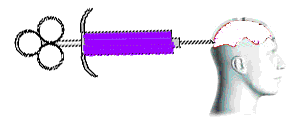The "Hypodermic
Needle Theory" implied mass media had a direct, immediate and powerful
effect on its audiences. The mass media in the 1940s and 1950s were perceived
as a powerful influence on behavior change. Our teaser trailer must influence
the audience to go and view our film in the cinema, by the use of exciting and
thrilling motions, but it must not effect them in such a way in that they want
to go and behave like the characters in the film.
The theory suggests that the mass media could influence a very large group of people directly and uniformly by 'injecting' them with certain messages designed to trigger a desired response.
There are two images used to express this theory (a bullet and a needle) both suggest a powerful and direct flow of information from the sender (mass media) to the receiver (viewer). The bullet theory graphically suggests that the message is a bullet fired from the 'media gun' into the viewer's 'head'.
They suggest that the media is a dangerous way to communicate an idea across because the receiver or audience is powerless to resist the impact of the message. The population is seen as a sitting duck. People end up thinking what they are told because there is no other source of information.
The two step flow of communication model hypothesizes that ideas flow
from mass media to opinion leaders and then to a wider population. Since our
teaser trailer does not feature any opinion leaders (such as famous actors)
then this theory will not apply to us.
Opinion leaders tend
to be similar to those they influence - based on personality, interests,
demographics, or sociological-economic factors. These leaders tend to influence
others to change their attitudes and behaviors. Large figures such as Lady Gaga
has influenced many people through the media to change their fashion style
through her own wacky mix of clothes she wears. The two-step theory refined the
ability to predict how media messages influence audience behavior and explains
why certain media campaigns do not alter audiences' attitudes.


No comments:
Post a Comment